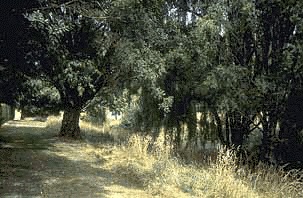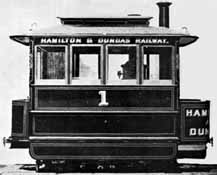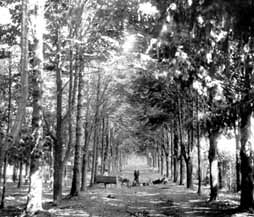 Official Name:
Official Name:
AINSLIE WOOD PARK
Formerly: Ainslie's Woods, Ainslie's Wood
Location: from Whitney Ave., Emerson Ave., Clifford St. and Leland St., to behind Alexander Park, at the end of Iona Ave. and Ainslie Ave. - Ward 1
Survey Descriptions: 200 & 210 Emerson St.: Registered Compiled Plan 1480, part of Lot 76; 135 Leland St.: Registered Compiled Plan 1480, Lot 82; 50 Hillview St.: Registered Compiled Plan 1480, Lot 101; 10 Clifford St.: Registered Compiled Plan 1478, part of Lot 43, Reference Plan 62R2149, part 1, part of Part 2
Size: 0.85 hectares (2.10 acres) City land, and 1.18 hectares (2.92 acres) Hydro land
Official Naming Date: November 24, 1987
Feature: walkway
History
In the late 1800's, Ainslie Wood was the place that Hamiltonians loved most to picnic, bird-watch, draw, paint and hike. This private land was owned by Colonel Robert C. Ainslie (sometimes spelled Ainsley or Ainslee), who had inherited the 24.28 hectare (60 acre) farm in what was then called Barton Township from his father, George Howlett Ainslie. Already a beautiful spot containing ravines, a spring, stream and waterfall, Col. Ainslie added "boat" swings, confectionery booths, a ball field, and pavilion with birds, raccoons, coyotes, monkeys, and other animals, to help visitors pass the time.
 By 1879, Ainslie's Wood grew so popular that the Hamilton and Dundas Radial Electric Railway began offering rail service there. The steam engine, that took its first trip on May 23, looked more like a street car than a train, and was nicknamed "the dummy" by its riders. The dummy train left the Ferguson Ave. station with 2 or 3 passenger wagons, and drove along Main, MacNab, Hannah (Charlton Ave.) and Queen streets. The Ainslie's Wood stop on the way to Dundas was at the end of Aberdeen Avenue, at what was then the south-western border of Hamilton.
By 1879, Ainslie's Wood grew so popular that the Hamilton and Dundas Radial Electric Railway began offering rail service there. The steam engine, that took its first trip on May 23, looked more like a street car than a train, and was nicknamed "the dummy" by its riders. The dummy train left the Ferguson Ave. station with 2 or 3 passenger wagons, and drove along Main, MacNab, Hannah (Charlton Ave.) and Queen streets. The Ainslie's Wood stop on the way to Dundas was at the end of Aberdeen Avenue, at what was then the south-western border of Hamilton.
At the turn of the century, when Ainslie's Wood was most popular, many local writers and reporters wrote about the wood. For instance, the happy times many people spent there are described in a poem by Miss M.E. Campbell called "Remember?". Mabel Burkholder tells a story about a duel Col. Ainslie himself once had there, using a pistol filled with currant jam!

Local politicians considered buying Ainslie Wood for an official public park as early as the 1880's. However, because the Crystal Palace grounds (Victoria Park) and Dundurn Park were so close to it, they decided the City did not need another park.
In 1885, a railway company bought the woods, built a sports field for baseball, cricket, lacrosse and similar sports, and opened the new park to the public. However, by 1895, it had lost a lot of popularity because Canada Westinghouse built a railroad yard nearby.
In 1920, it was rumoured that Detroit promoters wanted Ainslie's Wood for an amusement park, theatre and airport with car access, but plans for this development were never finalized. Instead, around this time Sir John Gibson bought Ainslie's Wood, and kept the Ainslie name. After his death, a part was donated by Lady Gibson and her family to the Hamilton Parks Board, while the rest went to Hillfield School in memory of her late husband and 3 sons.
In 1961, the City sold 38.23 acres of Ainslie's Woods for $67,345 to build the Chedoke Expressway, now called Highway 403 (between the Main St. East and Ancaster exits). Hillfield school moved to its present location on the mountain in 1963, and sold its part of the Ainslie property to the developers of the Camelot Towers Apartments and the Board of Education. The Board of Education opened the Ainslie Wood Vocational School near the station end of the property in 1970. Many students studied there until 1994, when it closed due to problems with funding.
Today's Ainslie Wood Park was not an actual part of the original Ainslie farm. The park is located on lands formerly owned by the Bowman and Bamberger families. The name Ainslie Wood Park comes from the Ainslie Wood Neighbourhood in which it is located.
References:
1. Annual Report of the Board of Park Management for the City of Hamilton, 1961.
2. Bailey, Thomas Melville and Charles Ambrose Carter. Up and Down Hamilton. Hamilton: Griffin, 1971. p. 25.
3. Burkholder, Mabel. Out of the Storied Past. vol. 2. p. 83-84. Special Collections, HPL.
4. Burkholder, Mabel. Out of the Storied Past. vol. 4. p. 123, 126. Special Collections, HPL.
5. Clipping File. Hamilton - Parks - Ainslie's Woods. Special Collections, HPL.
6. Corporation of the City of Hamilton, Department of Public Works and Traffic, Parks Division, Park Development Section. Parks Master Plan database, 1996.
7. Hamilton Mountain News. April 6, 1994. p. 9.
8. Head-of-the-Lake Historical Society, Hamilton, Ontario. Wentworth Bygones. no. 9. Hamilton: Walsh, 1971. p. 12.
9. Henley, J. Brian. Our Heritage Scrapbook. vol. 5. p. 97-98. Special Collections, HPL.
10. Jardine, David N. West Hamilton, a Village and a Church. 1990?. p. 11.
11. Picture Collection. Hamilton - Parks - Ainslie's Woods. Special Collections, HPL.

 By 1879, Ainslie's Wood grew so popular that the Hamilton and Dundas Radial Electric Railway began offering rail service there. The steam engine, that took its first trip on May 23, looked more like a street car than a train, and was nicknamed "the dummy" by its riders. The dummy train left the Ferguson Ave. station with 2 or 3 passenger wagons, and drove along Main, MacNab, Hannah (Charlton Ave.) and Queen streets. The Ainslie's Wood stop on the way to Dundas was at the end of Aberdeen Avenue, at what was then the south-western border of Hamilton.
By 1879, Ainslie's Wood grew so popular that the Hamilton and Dundas Radial Electric Railway began offering rail service there. The steam engine, that took its first trip on May 23, looked more like a street car than a train, and was nicknamed "the dummy" by its riders. The dummy train left the Ferguson Ave. station with 2 or 3 passenger wagons, and drove along Main, MacNab, Hannah (Charlton Ave.) and Queen streets. The Ainslie's Wood stop on the way to Dundas was at the end of Aberdeen Avenue, at what was then the south-western border of Hamilton.
 Official Name:
Official Name:

